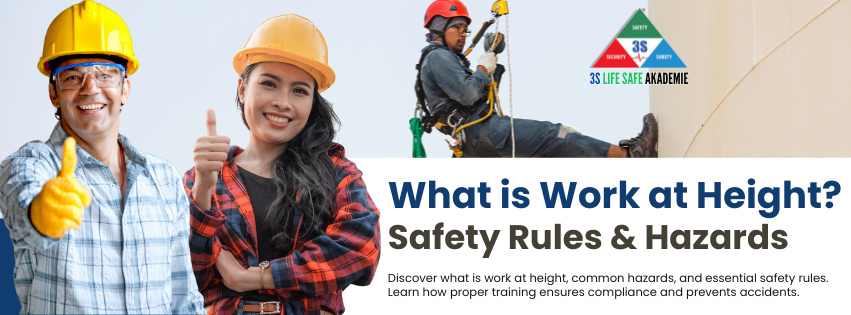
Posted by:- Sushant Mishra
13-09-2025
What is work at height and why does it matter for workplace safety? In simple terms, working at height refers to any activity carried out at a level where a fall could result in personal injury. This includes jobs done on ladders, scaffolds, rooftops, or even open platforms. According to safety statistics, falls from height are one of the leading causes of workplace injuries and fatalities worldwide.
Understanding work at height safety is essential for both employers and employees to ensure compliance with regulations and reduce risks. From construction sites to maintenance work, hazards are everywhere, but with proper safety measures, training, and awareness, accidents can be prevented. In this blog, we'll explore what is work at height, its hazards, safety rules, and why proper training is the key to keeping workplaces secure.
When we ask, what is work at height, it refers to any work situation where a person could fall from a distance liable to cause injury. This includes working above ground or floor level, near openings in the floor, or at the edge of a surface. As per OSHA and the Indian Factories Act, working at height covers activities like:
Even tasks carried out just a few feet above the ground can be risky without the right precautions. For instance, changing a light fixture using a ladder is also considered working at height. It's not just large construction projects but also everyday workplace maintenance that fall into this category.
The question “what is work at height” is crucial because many organizations underestimate these risks. By defining it clearly, we can identify hazards, implement safety rules, and ensure that every worker is protected.
When discussing working at height hazards, it's important to note that falls are not the only danger. Several risks contribute to workplace accidents:
Each of these working at height hazards can be minimized with proper planning, training, and protective equipment. For example, wearing a safety helmet reduces the risk of injury from falling objects, while weather assessments prevent unsafe work during storms. Identifying hazards early is the foundation of prevention.
Ensuring work at height safety means following strict rules and best practices before, during, and after the task. Key measures include:
By following these work at height safety rules, companies not only protect their workforce but also remain compliant with legal requirements. Safety is not just a rule—it's a responsibility.
One of the most effective ways to reduce risks is through proper training. Every employer should ensure that both workers and supervisors receive structured education in working at height safety. Training helps workers recognize hazards, use equipment correctly, and respond in emergencies.
Globally recognized certifications such as NEBOSH and IOSH offer essential safety training. At 3S Life Safe Akademie, we provide specialized Work at Height Safety Training programs designed to build awareness and practical skills for industries across India.
👉 Enroll in our Work at Height Safety Training and take the first step towards a safer workplace.
The importance of work at height safety cannot be overstated. Workplace accidents due to falls not only result in injuries and fatalities but also lead to legal consequences, loss of productivity, and financial setbacks.
By implementing proper safety rules, providing training, and ensuring compliance, organizations can drastically reduce accidents. Ultimately, work at height safety protects workers, ensures compliance with the law, and builds a culture of responsibility within the organization.
In summary, what is work at height? It's any activity where a fall could cause harm. From construction sites to routine maintenance, working at height hazards such as slips, falls, and falling objects remain a serious concern. However, with the right work at height safety rules, training, and equipment, these risks can be controlled.
Working at height comes with hazards, but with proper safety measures and certified training, accidents can be prevented.
Work at height means performing any job where there is a risk of falling and causing injury. This includes working on ladders, scaffolds, rooftops, towers, or near open edges. Even tasks carried out just a few feet above the ground are considered working at height.
The biggest working at height hazards includes falls from ladders, slipping from wet or unstable platforms, falling objects, fragile roofs, poor weather conditions, and lack of protective equipment. These hazards make work at height one of the riskiest activities in the workplace.
Yes. Any activity done using a ladder—whether a step ladder or an extension ladder—counts as working at height because a fall, even from a short distance, can cause serious injuries.
Important work at height safety rules include: conducting a risk assessment before starting, using safe ladders and scaffolds, wearing PPE like helmets and harnesses, inspecting equipment regularly, and having proper supervision with an emergency rescue plan.
Work at height safety is important because falls are a leading cause of workplace accidents and severity is high resulting in fatalities. Following safety rules reduces injuries, saves lives, ensures legal compliance, and builds a safe working culture in organizations.
Essential PPE for working at height includes safety helmets, full-body harnesses, lanyards, fall arrest systems, safety shoes, and in some cases, gloves and eye protection. Proper PPE greatly reduces injury risks.
Yes. Training is mandatory to ensure workers understand the risks, use equipment safely, and follow emergency procedures. Certified training improves both worker safety and employer compliance with regulations.
Employers are legally responsible for providing safe equipment, proper training, and supervision. However, workers also share responsibility by following safety rules and using PPE correctly.